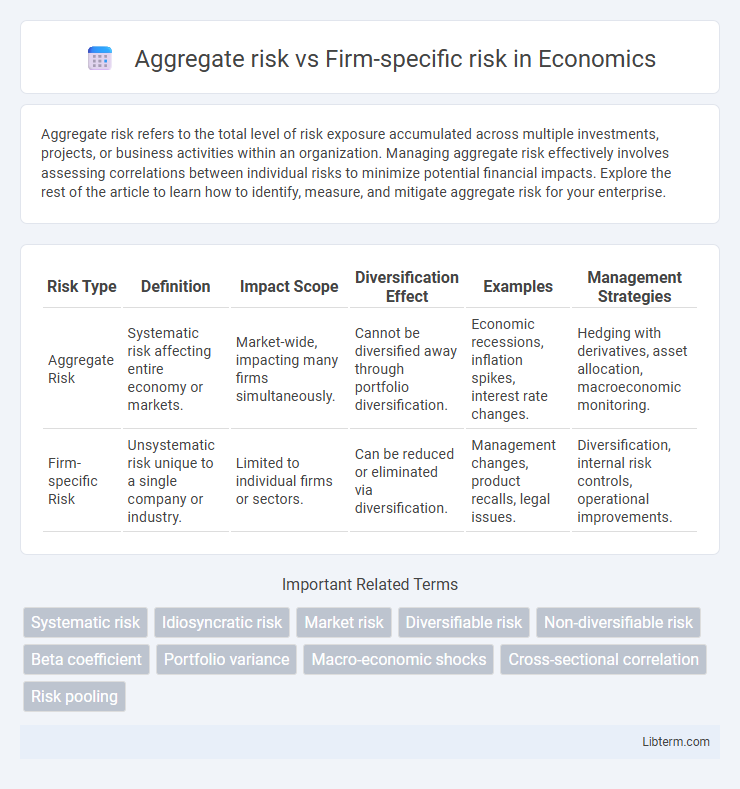Aggregate risk refers to the total level of risk exposure accumulated across multiple investments, projects, or business activities within an organization. Managing aggregate risk effectively involves assessing correlations between individual risks to minimize potential financial impacts. Explore the rest of the article to learn how to identify, measure, and mitigate aggregate risk for your enterprise.
Table of Comparison
| Risk Type | Definition | Impact Scope | Diversification Effect | Examples | Management Strategies |
|---|---|---|---|---|---|
| Aggregate Risk | Systematic risk affecting entire economy or markets. | Market-wide, impacting many firms simultaneously. | Cannot be diversified away through portfolio diversification. | Economic recessions, inflation spikes, interest rate changes. | Hedging with derivatives, asset allocation, macroeconomic monitoring. |
| Firm-specific Risk | Unsystematic risk unique to a single company or industry. | Limited to individual firms or sectors. | Can be reduced or eliminated via diversification. | Management changes, product recalls, legal issues. | Diversification, internal risk controls, operational improvements. |
Introduction to Aggregate and Firm-specific Risk
Aggregate risk refers to the overall risk impacting the entire market or economy, influenced by macroeconomic factors such as inflation, interest rates, and geopolitical events. Firm-specific risk, also known as idiosyncratic risk, is unique to a particular company and arises from factors like management decisions, product recalls, and operational failures. Understanding the distinction between aggregate and firm-specific risk is crucial for effective portfolio diversification and risk management strategies.
Defining Aggregate Risk
Aggregate risk refers to the total risk exposure faced by an entire market or economy, encompassing all sources of uncertainty that can impact multiple firms simultaneously. This type of risk includes macroeconomic factors such as inflation rates, interest rate fluctuations, political instability, and natural disasters, which often lead to correlated losses across many businesses. Unlike firm-specific risk, which pertains to individual company issues, aggregate risk cannot be diversified away through portfolio management.
Understanding Firm-specific Risk
Firm-specific risk refers to the uncertainty associated with individual companies due to factors such as management decisions, product recalls, or regulatory changes affecting that firm alone. This type of risk can be mitigated through diversification since it does not impact the entire market or industry. Understanding firm-specific risk involves analyzing financial statements, competitive positioning, and operational efficiencies unique to that company.
Key Differences Between Aggregate and Firm-specific Risk
Aggregate risk refers to the overall risk that affects the entire market or economy, such as economic recessions or geopolitical events, while firm-specific risk pertains to factors unique to an individual company, like management decisions or product failures. Aggregate risk impacts all firms simultaneously and cannot be eliminated through diversification, whereas firm-specific risk can be mitigated by holding a diversified portfolio of stocks. Understanding the distinction is critical for investors to manage portfolio risk effectively and optimize returns.
Examples of Aggregate Risk Events
Aggregate risk events include natural disasters like hurricanes and earthquakes that simultaneously impact multiple industries and regions, causing widespread economic disruption. Pandemics, such as COVID-19, represent aggregate risks by affecting global supply chains, labor markets, and consumer demand across various sectors. Financial crises, exemplified by the 2008 global recession, demonstrate aggregate risk through systemic failures that lead to significant market volatility and declines in asset values worldwide.
Illustrative Firm-specific Risk Scenarios
Firm-specific risk refers to uncertainties unique to a particular company, such as management changes, product recalls, or regulatory fines, which can directly impact its stock price and financial performance. Illustrative firm-specific risk scenarios include a sudden CEO departure causing investor uncertainty, a defective product leading to costly recalls, or a lawsuit resulting from compliance failures. These risks contrast with aggregate risk, which affects the broader market or economy, highlighting the importance of diversification to mitigate company-level vulnerabilities.
Impact on Portfolio Diversification
Aggregate risk, also known as systematic risk, affects the entire market and cannot be eliminated through diversification, impacting all assets simultaneously. Firm-specific risk, or unsystematic risk, is unique to individual companies and can be effectively reduced by holding a diversified portfolio of assets. Portfolio diversification primarily mitigates firm-specific risk, enhancing risk-adjusted returns without eliminating exposure to aggregate market fluctuations.
Managing Aggregate vs Firm-specific Risk
Managing aggregate risk involves strategies that address broad market or systemic uncertainties impacting multiple firms simultaneously, such as diversifying investments across various sectors or utilizing hedging instruments like index futures. Firm-specific risk management requires targeted actions tailored to individual company vulnerabilities, including improving operational efficiencies, enhancing corporate governance, and securing specialized insurance policies. Effective risk management integrates both approaches to balance-wide exposure reduction and customized safeguards, optimizing overall financial resilience.
Implications for Investors and Businesses
Aggregate risk impacts all market participants simultaneously, making diversification less effective for mitigating losses during economic downturns. Firm-specific risk, unique to individual companies, can be minimized through portfolio diversification, reducing the overall volatility for investors. Businesses must manage firm-specific risks through strategic operations while preparing for aggregate risks by maintaining sufficient capital reserves and risk management frameworks.
Conclusion: Balancing Risk for Optimal Performance
Balancing aggregate risk and firm-specific risk is crucial for achieving optimal performance and long-term sustainability. Effective risk management requires diversification to mitigate firm-specific risks while maintaining a strategic approach to aggregate risk that impacts the entire market or economy. Companies that successfully balance these risks can enhance resilience, improve decision-making, and maximize shareholder value.
Aggregate risk Infographic

 libterm.com
libterm.com